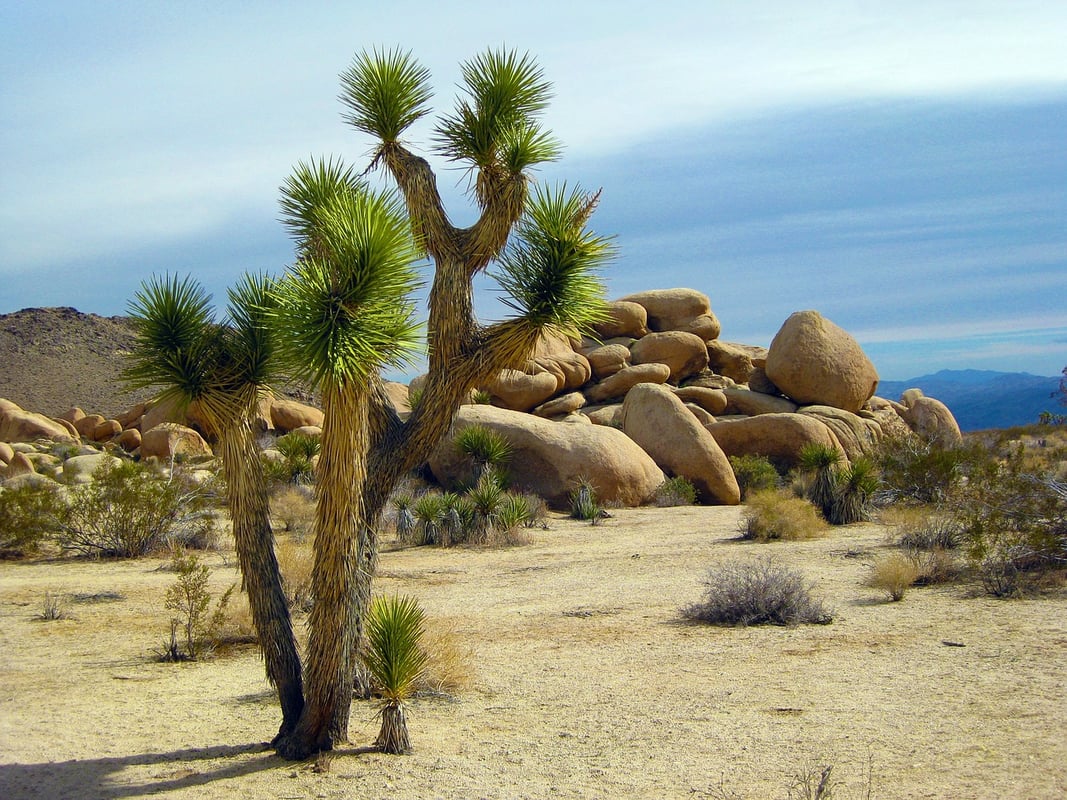An ecosystem is a structural and functional unit where living things interact with one another and their surroundings. The different types of ecosystems can range in size from a little oasis in the middle of a desert to an ocean covering thousands of miles. In this article, we will explain the five types of ecosystems and the differences between them.

1. Forest ecosystems
Forest ecosystems are an incredibly complex web of different tree and animal species, plus many fungi and bacteria species interacting with one another. These types of ecosystems vary according to the climate they are in; the world’s most biologically diverse ecosystems are found in tropical rainforests, which have many tree and animal species. However, temperate and boreal forests also have their own respective flora and fauna species.
Key characteristics of forest ecosystems include:
- Canopy: Forests are defined by their dense canopies, formed by tall trees that compete for sunlight. The canopy provides shade and creates a unique microclimate, influencing temperature and humidity within the ecosystem.
- Layers: Forests have distinct vertical layers, including the emergent layer (topmost), canopy layer, understory, and forest floor. Each layer supports different species, from towering trees to smaller plants and various animals.
- Biodiversity: Forests boast incredible biodiversity, housing countless species of plants, animals, and microorganisms. They provide habitats for a diverse range of creatures, from large mammals to insects and birds.
- Nutrient cycling: Forest ecosystems excel in nutrient cycling, where organic matter decomposes and releases essential nutrients back into the soil. This process ensures the continuous growth and sustenance of the forest community.
Read more: 10 Vital ecosystem services: sustaining life on Earth
2. Grassland ecosystems
Grassland ecosystems are found across a variety of the world’s different climate zones, from tropical savannas to mid-latitude steppes and even across sections of the tundra biome.
Help preserve ecosystems by reducing your environmental impact
A variety of different grass species make up much of grassland ecosystems, along with different species of small plants, shrubs, and sometimes the occasional tree. As a result, these types of ecosystems have lower biological diversity than forests. However, a range of animal species, from mammals to insects, inhabit grasslands, with herbivores feeding off the grass and carnivores consuming other animal species.
Key characteristics of grassland ecosystems include:
- Grasses: Grasses, both tall and short, form the primary vegetation in grassland ecosystems. They have adapted to withstand most harsh effects of grazing and fire, and their extensive root systems enable them to survive in nutrient-poor soils.
- Herbivores: Grasslands support a diverse array of herbivores, including zebras, bison, antelopes, and prairie dogs. These animals play a crucial role in shaping the grassland ecosystem by grazing on the abundant grasses.
- Fire adaptations: Grasslands are often subject to natural fires, and many plant species have evolved adaptations to survive and even benefit from these fires. Some grasses and wildflowers have fire-resistant tissues or produce heat-activated seeds.
- Seasonal changes: Grasslands experience distinct seasons, with periods of intense growth during the wet season followed by dry seasons. These seasonal variations influence the abundance and behaviour of both plants and animals in the ecosystem.
Read more: The ecosystems of Africa
3. Desert ecosystems
Deserts are all over the world. These are arid areas with scanty amounts of flora. The nights are chilly, and the days are scorching.
The desert ecosystem is the driest ecosystem on Earth, which accounts for its lack of vegetation and low biological variety. It is a component of the terra firma ecosystem. Desert ecosystems' flora and animals have learned the skill of enduring extreme environments.
Key characteristics of desert ecosystems include:
- Water scarcity: Deserts receive minimal rainfall, and water availability is a crucial limiting factor for life. Desert plants have evolved strategies such as deep root systems, succulent leaves, or the ability to remain dormant for extended periods to conserve water.
- Xerophytic adaptations: Xerophytes, plants adapted to arid conditions, often have small leaves, thick cuticles, and spines to reduce water loss. Some desert animals, like camels, have specialised physiological mechanisms to conserve water and tolerate high temperatures.
- Nocturnal activity: Many desert animals have adapted their behaviour to the extreme temperatures of the desert by becoming nocturnal creatures. They are active during the cooler nighttime hours, conserving energy and avoiding the scorching heat of the day.
- Sand dunes and rock formations: Deserts are often characterised by iconic features such as sand dunes and unique rock formations. These geological structures are shaped by wind and water erosion over thousands of years, adding to the scenic beauty of the desert landscape.
Read more: Preventing desertification: Top 5 success stories
4. Tundra ecosystems
The tundra ecosystem has a relatively low biological diversity due to the incredibly harsh cold conditions that occur in these ecosystems during much of the year. Typical plant species include low-lying grasses, plants, and shrubs, which are designed to withstand the frequent winds and heavy snowfalls that occur.
Trees are coniferous and found in slightly warmer parts of the tundra. The ecosystem is well-timed so that, during the short summer, the tundra bursts into life—plant species bloom and grow, insect pollination takes place, and animals give birth to their young. Many migratory bird species call the tundra their home during the summer.
Help restore ecosystems with our carbon credits
Key characteristics of tundra ecosystems include:
- Permafrost: Tundra regions have a layer of permanently frozen subsoil called permafrost. This frozen ground restricts the depth of plant roots and influences drainage patterns, shaping the overall ecosystem structure.
- Low vegetation: Tundra vegetation consists of hardy plants like mosses, lichens, and dwarf shrubs that can tolerate cold temperatures and short growing seasons. These low-lying plants form intricate mats that insulate the soil and provide habitats for small organisms.
- Migration and hibernation: Many tundra animals, such as caribou and Arctic foxes, undertake long-distance migrations to find food during the brief summer months. Others, like bears, enter a state of hibernation to conserve energy and survive the harsh winters.
- Fragile balance: Tundra ecosystems are particularly vulnerable to climate change. As temperatures rise, permafrost thaws, altering drainage patterns and impacting the delicate balance of the ecosystem. This makes preserving tundra regions crucial for mitigating harmful environmental effects.
5. Aquatic ecosystems
An aquatic ecosystem is defined as a community of organisms that live and interact with each other in a water-based environment. This encompasses a wide range of environments, including (but not limited to) marshlands, lakes, rivers, estuaries, seas, and oceans.
However, aquatic ecosystems have become increasingly threatened in recent decades due to pollution, vegetation removal, over-fishing, and invasive species. There are numerous approaches toward conserving marine ecosystems based on the nature of both the problem and the type of watercourse.
Read more: How to protect the oceans and marine life
Key characteristics of aquatic ecosystems include:
- Saltwater and freshwater: Aquatic ecosystems can be divided into saltwater (marine) and freshwater (inland) ecosystems. Each has unique characteristics and supports different organisms adapted to their specific salinity levels.
- Coral reefs and kelp forests: Coral reefs, found in tropical and subtropical regions, are hotspots of biodiversity, providing habitat to numerous fish, corals, and other marine organisms. Kelp forests, in colder coastal waters, create underwater forests that shelter a wide range of marine life.
- Wetlands and mangroves: Wetlands, including marshes, swamps, and bogs, are vital ecosystems that serve as nurseries for many species and provide essential services like water filtration. Mangroves in coastal areas act as protective barriers against storms and provide a habitat for diverse marine life.
- Adaptations to water: Aquatic organisms have evolved various adaptations for living in water, such as streamlined body shapes for efficient swimming, gills for extracting oxygen from water, and specialised organs for buoyancy control.
In conclusion, the conservation of ecosystems, regardless of their type, is of utmost importance. Forests, grasslands, deserts, tundras, and aquatic ecosystems all play vital roles in maintaining biodiversity and providing essential services to our planet. By reducing, reusing, and recycling our waste, we can minimise the negative impact on the environment and prevent pollution. Additionally, conserving water and energy resources is vital to ensure the sustainability of our ecosystems. Implementing eco-friendly practices, such as using energy-efficient appliances and adopting water-saving measures, can significantly contribute to this cause.
Furthermore, planting native trees and vegetation in our surroundings not only enhances the beauty of the landscape but also provides a habitat for various species and helps to maintain biodiversity. In addition, spreading awareness and educating others about the importance of preserving our ecosystems will foster a collective effort toward their protection.
Finally, by reducing your environmental impact by investing in nature-based projects like those of DGB Group, you make a tangible difference in the protection and restoration of ecosystems. These projects help to restore vital ecosystems and revitalise biodiversity. To reduce your environmental impact, start by measuring your carbon footprint and offsetting hard-to-abate emissions with our verified carbon credits. Carbon offsetting is a vital tool to restore nature and create a more sustainable future.
By implementing these measures, we can create a harmonious and thriving ecosystem for generations to come. Whether you are an individual, investor, or business, you can also make a difference and contribute to protecting ecosystems.




